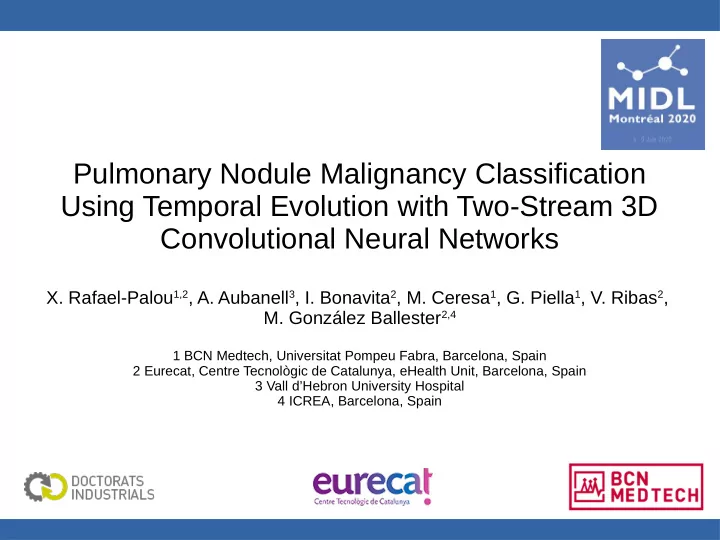

Pulmonary Nodule Malignancy Classification Using Temporal Evolution with Two-Stream 3D Convolutional Neural Networks X. Rafael-Palou 1,2 , A. Aubanell 3 , I. Bonavita 2 , M. Ceresa 1 , G. Piella 1 , V. Ribas 2 , M. González Ballester 2,4 1 BCN Medtech, Universitat Pompeu Fabra, Barcelona, Spain 2 Eurecat, Centre Tecnològic de Catalunya, eHealth Unit, Barcelona, Spain 3 Vall d’Hebron University Hospital 4 ICREA, Barcelona, Spain
Motivation CT Nodule malignancy assessment is complex, time-consuming and error-prone ➢ Visual inspection + quantification of current and follow-up nodules ➢ Current accurate predictive models (>86%) use datasets of nodules taken at single time- ➢ points and labels from visual judgements [Dey et al., 2018; Causey et al., 2018] Need of classifiers using nodule temporal evolution (>1 image) and cancer confirmed cases ➢ (e.g. biopsy)
Two stream 3D CNN Input Patches of centered nodule volumes Prep HU Clipping + Normalization FE Two copies of pre-trained ResNet-34 [Bonavita et al., 2019] from LUNA-16 [Setio et al., 2017] Generation of feature map pairs at different levels of the Nets CLS Flatten + concatenation of feature map pairs Fully connected bloc: FC + BNorm + Relu + DropOut Sigmoid Layer Feature-extraction Classification
Dataset ● Collected data – 161 patients, CT pairs at T1,T2 – 103 cancer - Histopathological confirmed – 58 benign - No growth or stability during >2 years – 1 nodule per patient – Incidental nodules (≥ 5mm) – Time interval (1 month – 6 years) – Annotations (centroid, diameter) from 2 radiologists ● Data preparation – Patches of 32x32x32 nodule centered – Random stratified partitions: train (70%) / test – 10-fold Cross-validation
Results Performance comparison of the TS-3DCNN vs 3DCNN using single nodule image Performance comparison (ROC-curves)
Conclusions & Future works ● Trained a Lung cancer classifier on a longitudinal cohort (>160 confirmed cases) ● Classifier learns from series of two 3D nodule volumes – Same patient – Different timepoints ● Transfer learning from LUNA-16 dataset (> 750K candidates) ● Extracted features from several levels do not enhance performance ● Results show that our method (TS-3DCNN) improves between 12% and 9% respect 3D networks with single nodule images ● Future work: – More patient data and from more time-points – Incorporate strategies to enable capture nodule evolution (such as RNN)
Thank you! javier.rafael01@estudiant.upf.edu xavier.rafael@eurecat.org Acknowledgements : Industrial Doctorates Program (AGAUR) grant number DI087 ● Spanish Ministry of Economy and Competitiveness (Project INSPIRE FIS2017-89535-C2-2-R, Maria ● de Maeztu Units of Excellence Program MDM-2015-0502)
Recommend
More recommend